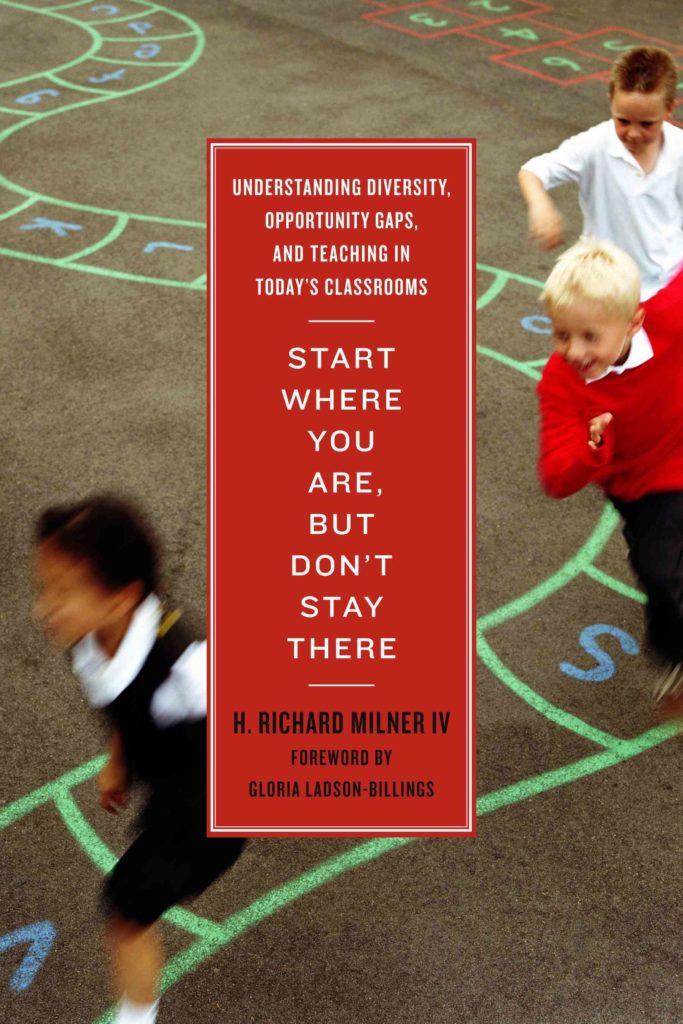All links to this book are Amazon Affiliate links, which means I receive a small commission on any purchase you make during that Amazon visit at no extra cost to you.
A few years ago, when I worked with student teachers, there was one question on their Work Samples that stumped them every semester. It was in the Contextual Factors section, which asked them to describe the characteristics of their host school and discuss how these factors would influence their planning. Here was the question that almost always drew a blank: How will the ethnic/racial diversity of your students inform your instructional choices?
Some made a respectable attempt at this one — the language arts people talked about including multicultural texts, the social studies people said they would mention the historical contributions of people of color, and many said they would be sure to mix students up during group work or “look for tension” in classroom dynamics. They did try. But they hadn’t received any formal training or done any reading on this topic. So even if they had a general sense that race and ethnicity might have an impact on their classroom, they had no idea what to do about it.
If I could go back now, I would give them Start Where You Are, But Don’t Stay There. In this book, H. Richard Milner digs into the teacher-student dynamic through the lens of cultural diversity, identifying a set of best practices for teaching a culturally diverse population…even in schools that aren’t very diverse.
Aren’t we past all that?
It’s not uncommon for people to believe that race is no longer an issue — in our country or in our classrooms. I mean, come on, the argument goes, We have a Black president now. To get this question off the table, let’s consider these points:
- A majority of respondents to a 2012 AP Poll expressed negative feelings toward both Black and Hispanic populations.
- The achievement gap between White students and students of color has been well-documented.
- Studies have shown that Black and Hispanic students are disproportionately given harsher discipline than their White counterparts for the same infractions.
- In 2012, the National Center for Education Statistics reported that in 2010, students of color made up more than 45 percent of public school students, but 83 percent of public school teachers are White. While our student population grows more diverse, our teachers stay about the same.
If you’re committed to the belief that race is irrelevant in 2014, you could probably argue around the significance of all these studies. If you’re not — if personal experience or a nagging feeling or just being human tells you that race and other forms of diversity make a difference in the classroom — then this book will help you reach all of your students more effectively. Supported by research, using fascinating case studies of ten teachers working in culturally diverse settings, Milner has identified the mindsets and practices that are most often found in teachers who reach more students more effectively.
What Works: Mindsets
Those who work well with culturally diverse* populations tend to share certain mind-sets, or ways of viewing their students and the world. Among these mind-sets are:
A rejection of color-blindness. For some people, being “not a racist” means being “color-blind,” claiming to not notice color or race in any situation, just “seeing people.” There is a persistent belief that not noticing color means you only care about who the person is on the inside. Unfortunately, what color-blindness ultimately does is ignore the reality that people of other ethnicities experience the world differently. Teachers who do well in culturally diverse settings acknowledge that race does matter, that it is important to learn about the ways race has impacted their students, and that ignoring this reality can actually contribute to making it worse.
Taking the idea of meritocracy with a big grain of salt. The belief in a meritocracy — the idea that people’s success is based solely on hard work and ability (in other words, merit) — can make teachers treat students who don’t succeed as if their failures are purely the result of lack of hard work and ability. Teachers who reject this idea — who recognize that student success depends on a complex array of factors, many beyond their control — are better able to take more effective approaches with their students.
Recognizing cultural conflicts. Sometimes what teachers perceive as misbehavior is actually the result of a cultural misunderstanding. In many other countries, for example, students are trained to never look a teacher in the eye. When a teacher in a more Eurocentric classroom demands that a student look at her while she’s reprimanding him, and that student resists, she may interpret this as defiance. Teachers who are mindful that their backgrounds are different from those of their students — even when they both come from the same country — are better able to avoid these kinds of problems.
What Works: Best Practices
As teachers develop the mind-sets that help them take a healthy approach to their culturally diverse students, they can also implement practices that produce the best results, such as:
Working with power structures among students. In all classrooms, certain students are natural leaders, whether or not they are academically successful. In schools where academic success is not a strong part of many students’ identities, teachers can leverage powerful students to move things in a different direction: Rather than struggle against the leaders, successful teachers get these students “on their side,” helping them realize the value of learning, which will then influence the others.
Bringing students’ real lives into the classroom. “Many students are forced to sit in classrooms without any real meaning or connection to what they care about,” Milner writes. He points to several approaches that make school more relevant to students: incorporating elements of pop culture into lessons, staying informed about students’ out-of-class events and extracurricular activities, and examining instructional materials for opportunities to include stories, contexts, and content that reflects students’ experiences.
Building relationships with students. If there is one idea that’s repeated most often in this book, it’s this: To teach our students effectively, it’s crucial that we get to know them, earn their trust, build relationships. Some teachers believe their only job is to teach their content. But building relationships with students — especially in urban contexts — is “essential for both educator and student success.” One way to make this happen is to help students get to know you by sharing personal stories, especially those that highlight things you have in common. Milner illustrates this by profiling Mr. Hall, a white teacher in a school with a large population of low-income minority students. Although Mr. Hall’s background was rural, he was able to connect with students by talking about his struggles growing up poor. With enough self-reflection, any teacher should be able to find the places where their experiences converge with those of their students. Sharing these will help students come to see teachers as real people, to trust them, and ultimately, to learn from them.
But my students are mostly White, so…
One of the most interesting issues Milner tackles in the book is the notion that many White teachers have when they teach a mostly White population: They believe diversity isn’t an issue for them. This was certainly true with my student teachers. For those who taught in all-White classrooms, their discussion of implications usually read like this: “Because my class is all Caucasian, ethnicity will not be a problem.” I saw this sentiment over and over again, and every time, I suggested that these students might be more in need than others of exposure to different cultures and perspectives. Milner recommends the same: “Students live in a multicultural society, which requires them to be able to understand their own and others’ privileges, or lack thereof, and the many ways in which people experience the world.”
In his profile of Dr. Johnson, a Black teacher in a mostly White school, Milner shows us one way that this kind of exposure can be accomplished. “Many of these kids don’t have any idea about how other people around the world live,” she says. “They are sheltered. They are good kids, but they just don’t see it…[so] I try and plan and develop a set of experiences for my students that will make them better human beings when they leave.” Although it sometimes caused tension, Dr. Johnson regularly exposed her students to texts that made them think about lives that were different from their own.
A Conversation with the Author
![Milner-8 (reduced size)[3]_0 (2)](http://cultofpedagogy.com/wp-content/uploads/2014/03/Milner-8-reduced-size3_0-2-166x250.jpg) Milner, who currently serves as the Dr. Helen S. Faison Chair in Urban Education at the University of Pittsburgh and the Director of its Center for Urban Education, talked with me via e-mail about the experiences that influenced his work on this book.
Milner, who currently serves as the Dr. Helen S. Faison Chair in Urban Education at the University of Pittsburgh and the Director of its Center for Urban Education, talked with me via e-mail about the experiences that influenced his work on this book.
“I had some wonderful teachers in school, and most of them worked hard to meet the needs of all their students,” he wrote. “But I grew up on the “south side” of my city and a common ethos of that neighborhood was that students did not succeed far beyond their current situations.
“I recall being called a ‘nigger’ in elementary school by one of my classmates, and my teacher told me to stop ‘making up stories’ when I shared it with her. I recall how one of my teachers literally turned her back to the ‘black-side’ of the classroom as she taught her classes, and this was hurtful because it did not make sense to me or my colleagues as high school students. But I grew up in a safe, affirming, loving environment with both my hard working, spiritually-grounded parents. Because my parents were so involved in my growth and development, they talked explicitly with me about how culture and cultural differences and similarities. These interactions with my parents were difference makers for me.”
Throughout the book, Milner works hard to make it clear that he has no interest in attacking White teachers. “I tried to make it overt that the teachers in this book are all different in terms of their race, ethnicity, teaching styles and philosophies, yet they are successful teachers of a diverse range of students. The idea is that teachers from any racial or ethnic background can be successful with any group of students if they have the knowledge and skills to be effective. Still, some teachers will read the book and believe I am arguing for same-race teachers to teach same-race students.”
Getting Started
There’s no way to fully convey all the ideas in this book here; to get the most out of it, you really need to read it. Even better: Read it with others. Start a book study group in your school or district, with others who share the same desire to better meet the needs of your students. To better facilitate this work, Harvard Education Press offers free downloadable discussion questions for Elementary Teachers and Middle and High School Teachers.
In order to start where you are, you have to know where you are, and that requires a lot of honest self-reflection, a belief that there is room for improvement, and an understanding that the skills of effectively teaching students from diverse backgrounds can be learned. “I rarely meet teachers who do not care about their students or who are not committed to them in a general sense,” Milner says. “However, they may fall short of engaging in the difficult work of teaching students whose needs are not met in classrooms. Good intentions are not enough.”
* In the book, Milner uses “culturally diverse” as a general term that includes racial and ethnic minorities, English-language learners, and those from lower socioeconomic backgrounds. His research focuses primarily on those populations, although he acknowledges that “diversity” includes aspects of gender, religion, ability, and sexual orientation, and that many of the principles outlined in the book would also apply to those populations.
Also by Richard Milner:
Join my mailing list and get weekly tips, tools, and inspiration—in quick, bite-sized packages—all geared toward making your teaching more effective and fun. You’ll also get access to my members-only library of free downloadable resources, including my e-booklet, 20 Ways to Cut Your Grading Time in Half, which has helped thousands of teachers spend less time grading!






